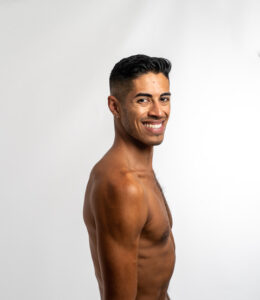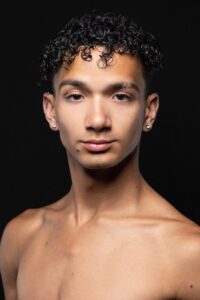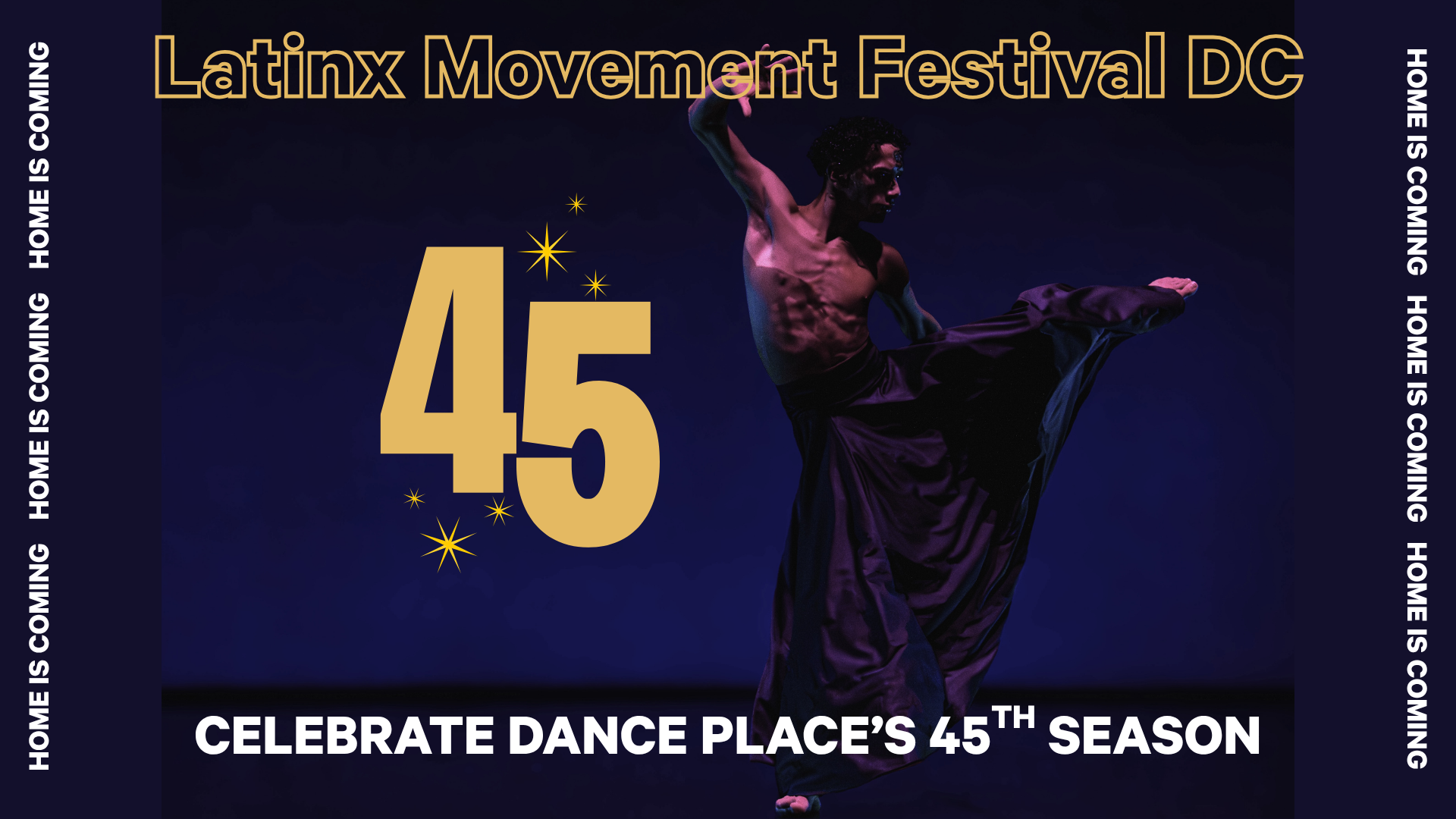
Gabriel Mata has been local to D.C. for eight years as a dancer, performer, choreographer, and educator.
“It’s been wonderful being part of the Artist Advisory Council and bringing the Latinx Movement Festival to life through Dance Place.”
Armani Colón is stepping into the D.C. dance scene after completing their undergraduate BFA degree in Baltimore.
“I’ve had the privilege of working with Gabriel on the Latinx Movement Festival, learning so much as a dancer, choreographer, artist, and even stepping into executive, leadership-type roles. It’s been a great experience, and we’re both excited to be producing our second festival at Dance Place.

Vision, Origins, & Community
Gabriel, you launched the festival in 2024, but I’m sure this idea had been brewing long before that. Can you walk us through the process of turning this vision into reality? What need did you see in the community that the festival addresses?
That’s a good question. There’s so many factors that come to mind. In developing the Latinx Movement Festival, I reflected on many Latinx-geared festivals throughout the nation: in San Francisco, in Texas, New York, and there was one in Virginia, and it was wonderful to see it being activated. But to my knowledge, there had not been one centered around movement in D.C, and I just refocused my mind of programming and production into facilitating that.
Our inaugural year was fortunately at Dance Place, and it was a national call, and we had local artists, as well as artists from California, Philadelphia, Florida, Texas, and even someone from Canada. But this year, the second year, we’re going to focus more on the local area, the DMV, to have a lot of local artists coming together.
One thing that I was aware initially is that we don’t have a group of 50 contemporary dancers who are Latino. But we do have a lot of artists who, I believe, are under the spheres of movement. You know, how can poetry and composition and music act as movement? When we recognize we don’t have so many dancers, but we have a lot of artists working within movement it’s exciting to pair up some of these artists together: one mover and one musician, one mover and one poet; and it’s going to be exciting to have them be in conversation, in a generative performative form.
I’m very curious to see what it looks like because in part, the richness of DC is that we are so dynamic in the way that we have Mexicans, Salvadorians, people from Central America and the Caribbean and also South America. And I think it’s a great way of bridging so many divides and having people come together.
Armani, you’re performing in the event, but you’re also doing some behind the scenes work as well. Can you describe your role and contributions in the festival?
Gabriel’s really been pushing me. I told him I wanted to learn from him and shadow him in all the directing and managing stuff. I started with marketing and media, managing Instagram, doing videos, reels, all that good stuff. We’ve been working together intensely and sharing ideas. Luckily, he handed me more responsibility for the festival and made me communications manager as well.
Interdisciplinary Practice & Personal Artistic Language
So, Gabriel, you touched on the interdisciplinary aspect of the Latinx Movement Festival. Has that been something that’s been a part of your personal artistic practice, or was that aspect new to you as you were drafting and facilitating the festival?
I don’t see myself as solely working under the capacity of dance. I create movement in a performance form called motion memoirs. For someone that has a background of growing up undocumented, the range of undocumented and immigrant artists is very few, and I just want to touch on that.
Knowing that there’s a deficit, I have the capacity, through motion memoirs, to work with past memories of when I was undocumented, when I was a Deferred Action for Childhood Arrivals (DACA) recipient, when I had a temporary visa, and then a permanent visa. So already, there are all these steps that I’ve navigated, and it makes me feel like I had a different body in each of those phases.
And in the work of dance, with those stories, with that narrative, motion memoirs were created. It was my way of connecting to my culture, to my stories, to our stories, in the many ways we have them. So my work uses narrative, spoken word, song, and movement, and I could see that being played out with other artists in the area.
How has it been, for you Armani, to work with another artist who isn’t a “dancer”?
I have the privilege of working with Juan Manú, Gabriel paired us up for the festival, and it’s been great. He’s an amazing violin performer, guitarist, great musician, singer, pianist– I don’t even know where to stop. He also has a history in movement, which we recently discovered in a rehearsal. So, he’s catching onto it. He is performing live music in it and we’re even exploring the movement capabilities that he can do well playing. He has movement experience, but not, you know, at the same level as a trained dancer. I think the biggest part of it is really finding that push to create a narrative and an emotional memo within the piece, especially because of that kind of limitation or imposed boundary. I love that that challenge has been given to me.
Home is Coming: Dance Place’s 45th Season
Okay, pivoting a little bit. As you may know, our 45th season theme at Dance Place is “Home is Coming.” It’s centered around the idea of home: what it means, how we define it, and how it shows up in our work.
So I’m curious, Gabriel, why did you choose Dance Place as the home for the Latinx Movement Festival? And how has Dance Place continued to be a kind of home or hub for your work?
In my eight years of being in D.C., I’ve had the great fortune of performing and presenting at Dance Place, but I never thought I’d have the capacity, or the time, to do something like the festival. So for me, it already feels like an achievement. And that sense of achievement is owed in part to Dance Place, because they’ve really been behind me with such strong support.
Dance Place feels like a sense of home to me, I know I can always call and have a good interaction with whomever I’m speaking to. In Mexico and Mexican culture, we all come together and that becomes our home. One person brings the beer, another brings the tamales, and so on. I’ve always thought that kind of collaborative gathering is exactly what happens at Dance Place. And that brings me a sense of comfort, and also a sense that I can push boundaries. Because no matter how I land, they’ll support me, offer feedback, and help me grow. It’s such a productive, conducive space to be in, and I know not many artists get that kind of privilege.
Honestly, I don’t know of another theater or institution in the DMV that is doing this kind of work for the Latino community. We don’t necessarily have the privilege to train in contemporary forms. First, because it tends to be a social access issue. And second, because it’s often seen as something outside of our cultural traditions. So for a Latino dancer, getting into contemporary form often means being very lucky, or occupying a position of privilege. The Latinx Movement Festival, in part, exists to be a home for the generative wealth and the dimensionality of how we can show up as artists. And for me, it’s one of the most unexpected dreams I didn’t know I needed. I needed this in my life, and Dance Place has been there to help me process through it.
Gabriel, You’re part of the Artist Council, which means you get that two-year period to develop and share your work with Dance Place, and then you get to pass it along to someone else, which is such a cool and exciting opportunity.
Looking at some of the other members you’re on the council with, is there anyone whose work really inspires you? Maybe someone you’d love to collaborate with, or someone whose artistic approach pushes you to think differently and learn more about dance and movement?
That’s hard. I’ll say, they all inspire me. They’re all great.
I love the work that Lauren does with The Line DC, and how it’s open to the community. She’s so consistent with facilitating classes and hosting open community events. It’s great that we get to experience dance in a way that isn’t just confined to the proscenium stage. That, to me, is such a richness—a richness that lives throughout all of us. It’s not just about dance happening in academic institutions. She’s a wonderful example of how technique, street knowledge, and cultural influences can come together and reflect the broad range of D.C. It’s really inspiring.
I also really admire the work Jane Raleigh has been doing in developing the DC Dance Network. When we lose an opportunity or access to a space or institution, I’m reminded of how few we have to begin with. The fact that she and her team had the capacity to bring up this idea and opportunity shows that just because we’re facing cutbacks doesn’t mean we have to settle for them. I love their efforts in building momentum around the identity of the D.C. choreographer. So much local funding is focused on youth training and youth education, which is important, but what about resources for working dance choreographers? Aside from what Dance Place offers, I feel like those opportunities are few and far between.
Final Remarks: The Latinx Movement Festival and Beyond
It’s important to mention that the festival doesn’t have a set form. Next year could look completely different. Next year could invite new people. It might not even take place in a theater, I don’t know. We really just work off community conversations, and we always bring in others to be part of that dialogue.
It’s really about trust. People had that trust in me, and I want to hold that same trust in others. Dance Place has trusted me, and that makes it easier for me to keep building on that trust, both in myself and in others. And yeah, I’m looking forward to seeing what else gets created.
Thank you to Gabriel Mata and Armani Colón for sitting down with me to talk about the upcoming 2nd Annual Latinx Movement Festival. We’re proud to provide a space for gathering and celebration for the Latinx community in D.C. Join us here at Dance Place festivals offerings of community classes and performances October 8th-11th!

